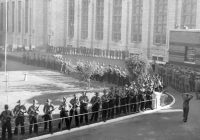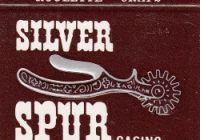|
Listen to this blog post here
Getting your Trinity Audio player ready...
|

Einstoss
1939-1941
Bernard “Bernie” Einstoss was a well-known gambler in Northern Nevada for nearly two decades, between 1947 and 1965.* Prior to that, he masterminded and executed a scheme to fix horse races** in California by bribing and threatening jockeys to “pull” the horses they commandeered, or keep them from winning.
Einstoss went by the name Barney Mooney and introduced himself to people as Mooney.** He earned the nickname “Big Mooney,” wrote John Christgau, “because he liked to sweep into fancy nightclubs and set up the house with drinks — especially champagne, if he was flush from a big winning bet” (The Gambler and The Bug Boy). Einstoss began placing bets in grade school on marbles and chocolates and by high school, which he dropped out of, had progressed to wagering on prize fights, horse racing, baseball and more.
How It Worked
Einstoss, 27, with the help of some accomplices, launched his race fixing scheme with the season’s start in 1939 in Southern California, where he ran a suite of bookmaking rooms in Los Angeles with fellow gamblers, Benjamin Chapman and I.W. “Doc Kebo” Kivel.
The three spread tips around Hollywood movie lots that specific horses were sure to win in certain races, and they’d take the bets on them. Specific targets were high rollers like George Raft and Don Ameche. Then Einstoss would have the jockeys riding those horses deliberately lose the races. The trio profited from the betters’ (or suckers’) losses, assuredly and amply.
Manipulation of Jockeys
Einstoss had intermediaries recruit and pay jockeys who could be bribed, typically those who were young, under age 20 for instance, vulnerable and desperate for money. Based on handicapping percentages, Einstoss determined which horses he wanted to lose and got word to the corresponding jockeys to “pull” them, sometimes multiple horses for one jockey in a day. Einstoss paid the riders $200 (about $3,500 today) per favorite and $100 ($1,700 today) per longshot horse they pulled and paid the go-betweens $200 per jockey they turned.
Einstoss had thrashed a jockey who hadn’t done what he’d asked, and most expressed a fear of him and belief that he’d kill them if provoked. In at least one instance, when a jockey failed to lose a race because he couldn’t physically restrain the horse, Einstoss told him, “You cost me $30,000! Thirty-thousand dollars! I’ve thrown boys in the ocean for less” (The Gambler and The Bug Boy). (This is equivalent to about $532,000 today.)
“These boys, I feel sorry for personally because I believe that they are just young kids, that is all, and they are not mature. They have not the state of mind to think things out … and they are tempted with easy money … far more than they ever saw before in their lives,” Jerry Giesler, chairman of the California Horse Racing Board, said at a hearing where numerous jockeys were compelled to tell what they knew about the race fixing.
Perpetrators Caught, Plot Halted
In November 1940, following an investigation, Einstoss was arrested and, eventually, so were his partners in crime. They were his brother, gopher and bet taker, Jack Einstoss; gamblers Chapman and Kivel; and two middlemen, Saul “Sonny” Greenberg, a horse trainer, and James Joseph Murphy, real name Irving Sangbusch, a race track follower.
Because fixing races wasn’t illegal (yet) in California, the group was charged with conspiracy and contributing to the delinquency of minors (the jockeys).
The Prosecution’s Case
At the trial, which began on February 28, 1941, the State of California argued that the defendants ran bookmaking establishments and through control of jockeys, altered the outcomes of races on which they’d accepted wagers and themselves had bet at the tracks. Prosecutors alleged that the group had fixed more than 100 races at various tracks — Hollywood Park, Del Mar, Bay Meadows and Tanforan — yielding an estimated $1 million (about $17.7 million today).
Sangbusch/Murphy testified for the state in exchange for removal of the charges against him. He explained that Reno, Nevada mobster and illegal gambler William “Bill/Curly” Graham had suggested to him that he contact Einstoss and had furnished the phone number. Sangbusch followed through, and the next day met with Einstoss, Kivel, Chapman and others at the bookies’ Hollywood headquarters, where they discussed the race fixing strategy. Subsequently, Sangbusch began working as an intermediary for the group. He admitted to having distributed about $20,000 ($355,000 today) in bribes from Einstoss to certain jockeys.
Defense: Gambler With Scruples
When Einstoss, free on $3,000 bail, took the stand, he claimed he made money by gambling on odds as opposed to race fixing through bribing jockeys. His attorney, Paul McCormick, argued that Einstoss was “always an honest gambler” (Los Angeles Times, May 3, 1941) yet admitted that Einstoss had given money to the jockeys and had known the jockeys, of their own accord, likely were going to pull their horses.
“But the facts are that the jockeys approached Einstoss,” not the other way around, McCormick added. “They were touting him to bet on certain horses and he paid them money for their tips. It is very probable that they might have pulled those horses to make their tips good and therefore collect more money.”
During final arguments, Einstoss “burst into tears,” got up, left the courtroom, went into an adjoining room, sat and sobbed (Nevada State Journal, May 16, 1941).
The End Result
After two months of testimony, at May’s end, the jury found Einstoss guilty on four misdemeanor counts of contributing to the delinquency of minors but not on the conspiracy charge. The judge ordered he serve a year in county jail and pay a $1,000 ($17,000 today) fine. The convicted man did both.
Subsequently, Einstoss moved to Reno, Nevada. Over the ensuing decades, he co-owned and had some involvement in the casino operations at the Mapes and Riverside hotels and the Horseshoe Club in Reno, along with the Bal Tabarin at Lake Tahoe in Crystal Bay. He had a smaller, nonoperational ownership in Caesars Palace in Las Vegas.
Most of the jockeys who participated in the plot were suspended indefinitely from horse racing in California.
* Bernard Einstoss died in 1966 at age 53 in Southern California.
** Horse racing under the parimutuel wagering system has been legal in The Golden State since 1933.
*** The name “Mooney” comes from the Gaelic word “maoin,” which translates into “wealthy” or “descendant of the wealthy one.”






